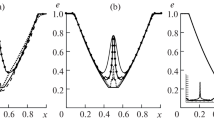Abstract
Error estimates for algorithms based on truncations for evaluating electrostatic interactions in molecular dynamics applications are very important for several reasons. For example, the estimates are necessary to establish the validity of the simulations and can be used to estimate various simulation parameters. Very precise estimates have been found for the Ewald method and the related particle mesh Ewald method. However, for the very popular fast multipole method such a precise estimate is not available. In this paper, we illustrate the rather complicated error behavior of the fast multipole method and we use statistical methods to derive an estimate for the root mean square error on the forces. Furthermore, the expected maximum error on the force acting on a single particle is studied. The estimates are tested against errors obtained from simulations and are found to be very precise.
Similar content being viewed by others
References
QUANTA Parameter Handbook, Polygen Corporation (1990).
M. P. Allen and D J. Tildesley,Computer Simulations of Liquids (Clarendon Press, Oxford, 1987).
T. Darden, D. York, and L. Pedersen, Particle mesh Ewald: Ann log(n) method for Ewald sums in large systems,J. Chem. Phys. 98:10089–10092 (1993).
S. W. de Leeuw, J. W. Perram, and E. R. Smith, Simulation of electrostatic systems in periodic boundary conditions. I. Lattice sums and dielectric constants,Proc. R. Soc. Lond. A 373:27–56 (1980).
K. Esselink, Large-scale simulations of many-particle systems, Ph.D. thesis, Rijksuniversiteit Groningen, The Netherlands (1995).
I. S. Gradshteyn and I. M. Ryzhik,Table of Integrals, Series and Products 5th ed. (Academic Press, New York, 1994).
L. Greengard and V. Rokhlin, A fast algorithm for particle simulations,J. Comp. Phys. 73:325–348 (1987).
L. Greengard, The rapid evaluation of potential fields in particle systems, Ph.D. thesis, Yale University, New Haven, Connecticut (1987).
F. Leathrum, Jr.: Parallelization of the fast multipole algorithm: algorithm and architecture design, Ph.D. thesis, Duke University, Durham, North Carolina, (1992).
J. Kolafa and J. W. Perram, Cutoff errors in the Ewald summation formulae for point charge systems,Mol. Simul. 9:351–368 (1992).
H. G. Petersen, D. Sølvason, J. W. Perram, and E. R. Smith, The very fast multipole method,J. Chem. Phys. 101(10):8870 (1994).
H. G. Petersen, Accuracy and efficiency of the particle mesh Ewald method,J. Chem. Phys. 103(9):3668–3679 (1995).
H. G. Petersen, E. R. Smith, and D. Sølvason, Error estimates for the fast multipole method. II. The three-dimensional case.Proc. R. Soc. Lond. A 448:401–418 (1995).
Author information
Authors and Affiliations
Rights and permissions
About this article
Cite this article
Sølvason, D., Petersen, H.G. Error estimates for the fast multipole method. J Stat Phys 86, 391–420 (1997). https://doi.org/10.1007/BF02180212
Received:
Accepted:
Issue Date:
DOI: https://doi.org/10.1007/BF02180212




